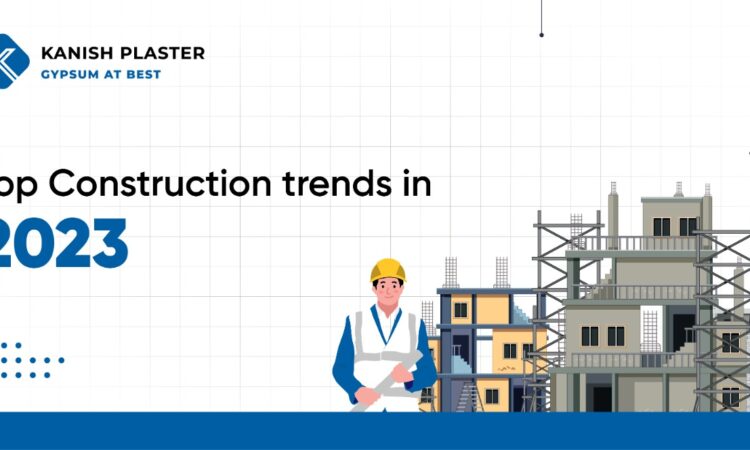Technological advancements, nature conscious consumers, and rise in infrastructure investments are expected to shape the construction industry. With more opportunities in residential, commercial, government, and industrial infrastructure, the construction industry looks very promising as far as 2023 is concerned. The year 2022 had strong headwinds from supply chain disruptions and shortages due to COVID-19 and the Russia- Ukraine conflict. Material prices were rising and this lead to increase in construction costs.
As a pioneer in the construction industry, our team of experts have analyzed the key trends that are expected to drive the construction industry in the year 2023.
- Green building
It is estimated that construction industry accounts for more than 40% of global Carbon-dioxide emissions. With increasing awareness on pollution and carbon emissions, the industry is working out ways to reduce carbon emissions and help build a better world. Consumers are also becoming environmentally conscious and they are in search for green building materials and ecofriendly constructives. Of the total carbon emissions, a major portion of them is from usage of cement. Alternatives like gypsum plastering are gaining popularity and momentum. They have evolved as a sustainable substitute for the emission- intensive cement materials. Builders and construction companies are looking for usage of more recyclable materials, constructives from waste, and so on.
- Technology to handle labour shortage
Labour shortages hindered the progress of construction industry in 2021 and 2022. COVID-19 and Russia- Ukraine conflict resulted in labour shortages. A lot of people changed their roles and domains when COVID hit and lockdowns were imposed. This hit the construction industry not just in India, but across the world. The industry employed people with no experience and skills to manage the shortage. This created safety challenges during and after construction.
Labour shortage led to
- Buildings not being completed on time.
- Projects taking time to start
Wage rates increased and builders and construction companies were struggling to complete the ongoing construction projects at the agreed upon cost. Higher wage rates also increased overall construction costs and construction companies were exploring alternatives and technological solutions that could reduce the requirements for labour.
- Low cost constructives
An Economic Times article revealed that the cost of construction materials have increased by 28% when compared to the prices that prevailed during the pre-COVID era. The rise in cost of construction inputs aggravated the overall cost of construction activities across the world. The industry is craving for low cost, affordable construction materials and solutions. With rising prices, home buyers are looking for affordable houses. So, the construction industry has to explore low cost construction materials and build upon processes that require less labour involvement.
- Digitalization in construction
Digitalization and internet have positively disrupted all walks of our lives. Yet, construction industry is still lagging behind when it comes to using digital technologies. Using mobile apps, enabling paperless construction, using drones and other technological solutions to monitor construction site, etc. would enhance the productivity of the construction industry. When you maintain data and information on paper, there are chances that you will lose track of them. Instead having an application or using a cloud server would help reduce hassles and help unlock new opportunities.
Construction companies could make use of the technological advancements to achieve energy efficiency, waste reduction, safety of labour and public, and monitor environmental conditions. Brick laying is a mundane, repetitive, yet a cumbersome task when done by humans. Using robots could help. Using AI, ML, and big data along with simulatory models could help achieve time, energy, and cost- efficient construction.
- Pre-fabricated construction
Prefabricated buildings are constructed using pre-fabricated structures and they are transported to the construction site for assembly. Such pre-fabricated construction mechanisms help save time and cost. They also reduce the chances for manual error and mistakes. Whether it is industrial buildings, commercial, or residential buildings, people are increasingly exploring offsite construction options. Given that the manufacturing industries in India are gaining a boost under the strategic initiative of ‘Make in India’, there is a huge scope for construction. They require buildings constructed in less time and at an accelerated pace. This increases the need for pre-fabricated construction.
How gypsum plastering could become the standard of Indian construction industry?
- Low cost construction
Gypsum plasters from Kanish Plasters reduce construction cost by 20% or to about Rs. 45 per sq.ft when compared to using traditional plasters like cement plasters. So, at a time when the Indian construction industry is grappling with cost and inflation issues, gypsum plasters could serve as an efficient alternative to cement plasters.
- Sustainable, environmentally friendly material
Gypsum plasters are made from naturally occurring mineral. The gypsum is deposited at the beds of sedimentary rocks found near ocean beds and lakes. They are completely natural and are an appropriate material for the construction industry that is woking out ways to diversify from cement to environment-friendly alternatives. Studies have shown that cement is a major contributor to emissions. Gypsum plasters and other gypsum based materials like gypsum boards could evolve as a sustainable construction material. Also, gypsum has low thermal conductivity and so can retain the moisture for long periods of time. This helps reduce electricity consumption during summer because gypsum plasters can keep the room relatively cool. In commercial and industrial buildings, gypsum plasters help maintain the air quality in the working space and ensure a salubrious working environment.
Gypsum plasters also reduce the consumption of water when compared to cement plasters in construction industry. This would be an important trending shaping up the construction industry in 2023. It is due to these reasons that gypsum plasters have already found a place when it comes to construction of hospitals and educational institutions.
- Quick construction
The fast paced world is such that customers need everything right at the moment. When it comes to construction, gypsum plasters save 75% of construction time. Gypsum plastering does not require water curing for 21 dayas or so as is the case with cement plastering. Gypsum plasters produce a smooth surface and so do not require putty application. The walls can be directly painted. All of these help save time and ensure an accelerated construction. To learn more about gypsum plasters vs cement plasters, read our blog at Is Gypsum Better Than Cement For Construction?
Overall, innovative materials and sustainable constructives would shape up the Indian construction industry in 2023. Adoption of digital technology may also become the norm to achieving the desired productivity and efficiency in construction. Technological evolution and adoption might displace the need for human labour to a certain extent. The construction industry should leverage futuristic technologies like robotics, AI, drones, etc. to achieve cost efficiency and reduce the dependence on manual labour. This could help solve the problems arising from labour shortages.
For gypsum plastering, visit www.kanishplasters.com.



